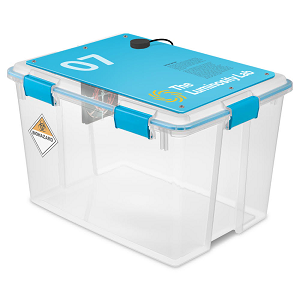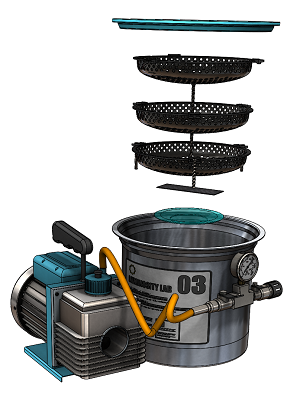Low-cost sterilization units combat N95 shortage, help businesses

Team member John Patterson examines one of two sterilization systems invented by the ASU Luminosity Lab. Photo courtesy of John Patterson
Students in the Arizona State University Luminosity Lab have created two versions of a low-cost, small-scale sterilization unit that is effective on general personal protective equipment, including increasingly scarce N95 masks.
They hope to help with the N95 mask shortage as well as help small businesses sterilize the masks and other equipment needed to keep their businesses running during the coronavirus pandemic. The project is just one part of Luminosity’s multifaceted response to the COVID-19 crisis.
At the onset of the pandemic, the students in the lab collectively identified the ways that they could best leverage their diverse skills to positively impact the situation. This resulted in a series of projects, from developing novel devices to assisting small businesses in adapting to the lockdown, as well as producing and delivering over 10,000 pieces of personal protective equipment through Luminosity’s PPE Response Network.
“During these efforts, it became clear that to alleviate the increased demand of personal protective equipment, production would need to be supported by an effective method to sterilize and reuse it. This is particularly relevant with N95 masks, which are in high demand, but more difficult to rapidly manufacture,” said Mark Naufel, executive director of Luminosity Lab. “The sterilization systems produced by our students are cost-effective, scalable solutions that can be produced and leveraged by schools, businesses and medical providers to help alleviate their personal protective equipment needs.”
The N95 problem
N95 masks, which filter out 95% of all airborne particles, are difficult to obtain during the pandemic, and not purely due to their high demand.
N95s are also a challenge to manufacture because they use a special material called melt-blown fabric, which is key to the masks’ filtration ability. Though factories can ramp up mask production, they reach a bottleneck when it comes to access to this material. Melt-blown fabric requires specialized machines to create it, and the machines themselves cost millions of dollars and take around six months to assemble.
These factors, combined with the increased necessity of N95 masks, mean that health care workers are forced to reuse the ones they have.
But to reuse these masks, they must be sterilized, and this too presents a challenge. Existing sterilization systems are extremely expensive and are only built for large-scale settings, like big hospitals. This leaves smaller hospitals, clinics and other small businesses without a way to easily or affordably sterilize their N95s and other personal protective equipment.
N95 masks are a challenge to sterilize because each sterilized mask must still meet the standard of filtering out 95% of airborne particles. It must also retain its unique fit to its user’s face, which ensures an airtight seal.
“It's been really cool to see how a team of five students is really all it takes to create innovative solutions to problems in society and also to push those solutions into actual, impactful products." — Nikhil Dave, ASU undergraduate student
“In designing these systems, we have to make sure that they not only eliminate any viral particles along with bacteria, but also that they don’t hurt these standards for the personal protective equipment,” said Katie Pascavis, a mechanical engineering undergraduate student who focused on those standards as part of the Luminosity team.
Testing how many viral particles are on a mask post-treatment, however, requires special labs and equipment that the student team didn’t have. So they put out a call to faculty across the university with the right tools and expertise.
“We were lucky to find amazing collaborators at ASU in the Biodesign Institute as well as a variety of schools. And those collaborators really helped push us forward in terms of actually testing the protocols,” said Nikhil Dave, a neuroscience and innovation in society undergraduate student and leader of the team.
The team also spent time testing how many times an N95 mask could go through their sterilization processes and emerge with those standards intact. It’s an important piece of data, because reusing an N95 mask at all is going against its original intent to be disposable, points out David Wallace, a PhD candidate in human systems engineering and member of the team.
“They were never designed in the first place to reuse. It’s essentially like asking someone to reuse a Kleenex, when it was not designed as a handkerchief,” Wallace said.
Sustainable sterilization

Rendering of the ozone sterilization system. Courtesy of ASU Luminosity Lab
The team created two sterilization systems. The first uses vaporized hydrogen peroxide and is intended to combat the N95 mask shortage. The second relies on ozone, and was designed to provide small businesses with a way to sterilize a variety of items, including clothing and reusable face masks. The ozone system is simple enough to be run from a car battery if electricity isn’t available.
“What's particularly notable about the ozone system is that, unlike most common sterilization systems or even our own vaporized hydrogen peroxide system, we don't need to put anything in it to generate the sterilization agent,” Dave said. “Rather, all we need is a power source, and it will continuously generate ozone gas. So it's environmentally sustainable and also a lot more cost effective.”

Rendering of the vaporized hydrogen peroxide system. Courtesy of ASU Luminosity Lab
“The cool thing about both these systems is that they are very easy to manufacture. They don't require specialized tools,” added John Patterson, an electrical engineering master’s degree student who leads prototyping and construction on the team. “These things don’t even need to be manufactured by professionals. These can be constructed by hobbyists. They can be constructed by teams of engineering students. Anyone who is interested in collaborating and contributing can do that.”
The team put new N95 masks through treatment cycles in both systems. After five cycles in the ozone system and 20 cycles in the vaporized hydrogen peroxide system, treated masks performed at the same level as new, untreated masks, suggesting that the systems were not weakening the masks’ filtration ability up to those amounts of cycling. However, the team pointed out that when the masks are being worn between each cycle, they will undergo more wear and tear and may degrade more quickly than they did in testing.
Portable, effective and affordable
The Luminosity team’s journey from drawing board to pending patents was one of incredible speed. In under three months, they designed, developed, scientifically validated and submitted invention disclosures for their two sterilization systems. Now, they hope to continue that momentum in order to deploy the systems anywhere they might be of help.
“It's been really cool to see how a team of five students is really all it takes to create innovative solutions to problems in society and also to push those solutions into actual, impactful products,” Dave said.
Key to their success, they note, is the fact that they were able to collaborate with many ASU departments as well as external health care partners.
“This was a great opportunity to see how collaboration can lead to prosperity for everyone involved, in terms of getting these systems built, getting them tested as quickly as possible, and hopefully to save as many lives as we can by getting the technology in the hands of those who need it,” Patterson said.
Part of their plan to make their technology accessible to the community was to intentionally create the systems with affordable materials. Vaporized hydrogen peroxide sterilization systems exist already, but they’re meant for large-scale settings like big hospitals and can cost up to $1 million.
The materials for the students’ vaporized hydrogen peroxide system, however, cost around $300. The ozone system is even cheaper, its materials costing around $60. The systems combine affordability with portability, and they sterilize just as effectively as the larger, pricier machines.
This makes them useful for a wide range of settings — not just hospitals and clinics, but also schools, businesses and locations with less resources.
“In developing nations or other places where maybe people can't afford personal protective equipment in large quantities, these would also be a great way for them to reuse equipment and cut some of those costs in a more sustainable fashion,” Pascavis added.

The team behind the sterilization systems. Clockwise from upper left: Katie Pascavis, Nikhil Dave, John Patterson and David Wallace. Not pictured: Abhik Chowdury. Photo courtesy Nikhil Dave
Ready for a new normal
Though the future of COVID-19 is unpredictable, it seems that face coverings and personal protective equipment will remain a part of society for the foreseeable future.
“Many large and small companies are requiring the use of face masks to reduce the spread of COVID-19. So I think, with personal protective equipment becoming a regular part of our daily lives, we're going to have to figure out creative and inventive ways to reuse the equipment that was built to be disposable,” Dave said.
The team is in conversations with the Arizona Commerce Authority and the Arizona governor’s office to determine how they can help get these systems out to businesses and schools around the state, allowing us to reopen stronger. They’ve also sent systems to a few health care facilities around the state, including Banner Health, that are providing the team with feedback.
However, those interested in using the team’s designs need not wait for a product rollout. They recently made the instructions for building and using the ozone system and the vaporized hydrogen peroxide system available by publishing them on the preprint server MedRxiv.
Businesses and other entities who want to obtain some of these units, as well as makers who are interested in helping produce more of these systems to meet the community’s needs, should contact Luminosity Lab Director Mark Naufel at mnaufel@asu.edu.
“The systems are ready,” Dave said. “We’d like to make them usable for anyone who feels like they can use them.”
Top photo: Team member John Patterson examines one of two sterilization systems invented by the ASU Luminosity Lab. Photo courtesy John Patterson
More Science and technology
2 ASU faculty elected as fellows to National Academy of Inventors
Arizona State University faculty members Bertram Jacobs and Klaus Lackner have been elected as fellows to the National…

Harvesting satellite insights for Maui County farmers
Food sovereignty can refer to having access to culturally significant foods, but Noa Kekuewa Lincoln believes it goes farther…

Google grant creates AI research paths for underserved students
Top tech companies like Google say they are eager to encourage women and members of historically underrepresented groups to…